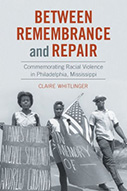Between Remembrance And Repair: Commemorating Racial Violence In Philadelphia, Mississippi

Author: Claire Whitlinger
Publisher: Chapel Hill, NC: University of North Carolina Press, 2020. 304p.
Reviewer: Renee Romano | February 2021
Nearly thirty years ago as historians, sociologists and other scholars began to produce a growing body of scholarship on historical memory, monuments, commemorations, and other memorialization efforts, historian Charles Maier warned that this “surfeit of memory” signaled a “retreat from transformative politics” (Maier, 1993). For Maier, memory activism—or efforts to define the past, to construct sites that enable an engagement with a particular history, or to raise awareness of marginalized historical narratives—represented a retreat into the past. Such activism, as he saw it, did not have the potential to shape a more equitable future. Yet memory politics have not abated in the years since Maier’s warning; indeed, the current heated struggle over Confederate monuments suggests that many activists believe deeply in the transformative capacity of new forms of commemoration.
Yet there has been little work, until now, that rigorously seeks to assess the actual political impact of commemoration or to make a case about what kinds of memory work might be transformative. In her compelling new book, Between Remembrance and Repair: Commemorating Racial Violence in Philadelphia, Mississippi, sociologist Claire Whitlinger offers a measured, careful, and ultimately convincing argument that certain commemorations of racial violence can transform the communities from which they emerge and facilitate broader forms of social and political change. Using as her case study the 2004 commemoration of the 1964 murders of James Chaney, Andrew Goodman, and Mickey Schwerner in Philadelphia, Mississippi, Whitlinger argues that the work of the local group that organized the commemoration led to meaningful change in the arenas of legal justice, education, and Mississippi’s political culture.
Between Remembrance and Repair operates at two levels. One part of the book offers a deeply grounded study of the work and impact of that local group, the Philadelphia Coalition, based on extensive research in archival and media sources, over sixty oral interviews, and ethnographic observations. The other draws on sociological theory, work on social movements, and scholarship on historical memory, to develop a general theory of when, why, and how commemorations of racial violence can lead to meaningful documented consequences of social change. Whitlinger is particularly interested in the potential impact of commemorations as distinct from other kinds of memory projects. Commemorations, she argues, have particular potential to be impactful because they embed memory work in a particular time and place; they encourage rituals and dramatic performances; and they have a cumulative impact in helping build a community’s mnemonic capacity since they take place every year.
To build her case, Whitlinger employs the methodological approach of comparative historical sociology: counterfactual analysis and systematic comparison. For her counterfactual analysis, she begins with a list of outcomes that could reasonably be linked to the 40th Anniversary Commemoration and then works backward to question whether these outcomes would have taken place if the 2004 commemoration had never happened. She eliminates outcomes where she does find enough evidence to link to the commemoration, such as the election of Philadelphia’s first black mayor. But she makes a compelling case that the 2005 trial of Edgar Ray Killen, Mississippi’s civil rights education bill, and the creation of the Mississippi Truth project (a group that sought to start a statewide truth and reconciliation process), can all be traced back to the commemoration. She develops a systematic comparison between the 2004 commemoration and one that took place in 1989 to explain why the 40th anniversary commemoration had a more transformative impact than the 25th anniversary did.
The crime at the heart of Whitlinger’s analysis is well-known: in 1964, in the midst of the civil rights movement’s Freedom Summer, three young activists disappeared and were later found dead. James Chaney, Mickey Goodman, and Andrew Schwerner had been murdered by the Ku Klux Klan, with the open assistance of several Neshoba County law enforcement officers. When the FBI investigated the crime, white Philadelphians refused to cooperate and blamed civil rights activists for inciting violence. Anyone who dissented from the community code of silence was ostracized. The state of Mississippi did not charge anyone for the murder of the three men. Although the federal government did convict several men on federal charges related to the crime, all of those convicted served short sentences and were soon reintegrated into the white community. While the local African American community held annual commemorations to remember the slain men, white residents of Neshoba County instead promoted a conspiracy of silence, seeking to erase the past and to force this event into obscurity.
The 2004 commemoration of the murders ruptured this dominant public silence, becoming only the second time in forty years that the official memory of the event was challenged locally. In 2004, motivated in part by a desire to rehabilitate Philadelphia’s public image and to showcase how much the city had changed since the 1960s, leading local residents decided to create a committee to plan a major public ceremony for the 40th anniversary of the murders. A major milestone anniversary, Whitlinger argues, can attract external attention that can motivate a local community to act. And in this case, a new group was soon formed to plan the commemoration. The Philadelphia Coalition represented a broad cross-section of Neshoba County residents. Leroy Clemons, the African American head of the NAACP and Jim Prince, the white editor of the local newspaper, co-chaired the committee. They recruited community stakeholders, including representatives from the local Choctaw tribe, and sought the approval of elected officials and city elites. With the support of the William Winter Institute for Racial Reconciliation at the University of Mississippi, the Philadelphia Coalition organized a highly successful commemoration. The event garnered widespread media praise, earned the support of the state’s Republican governor, and fueled efforts to build up the region’s civil rights tourism.
But the impact of this commemoration was much broader and extended well beyond the one-day event. The 2004 commemoration, the author shows, can be linked to significant developments in the arena of legal justice, education, and Mississippi’s civil sphere. The bulk of the book traces how the work of the Philadelphia Coalition led to a state trial and conviction of one of the men involved in the 1964 murder; to the passage of a state law mandating the teaching of civil and human rights history; and to the creation of the organizational groundwork for a truth and reconciliation process in Mississippi.
The 2005 trial of Edgar Ray Killen, Whitlinger insists, would not have taken place without the work of the Philadelphia Coalition. Despite the reopening and successful prosecution of many other civil rights era murder cases in the years before the commemoration, little progress had been made in convincing state authorities to reopen the Freedom Summer murder case. Indeed, in 2002 the Mississippi attorney general insisted that there was not enough evidence to reopen the case. But just three years later, the state brought charges against one of the surviving suspects. This change of heart, Whitlinger argues, was not due to the discovery of any new evidence or to successful pressure by relatives or journalists. Rather, the commemoration created a pathway to the trial after the members of the Philadelphia Coalition decided to make a call for justice part of their agenda. Their work to build broad support for reopening the case, to educate the community about why it was important, and to frame the call for a trial in moral terms helped shift the conditions of possibility surrounding the case and created political cover for the state to move forward with pressing charges. The author extracts from this example a broader understanding about the relationship between commemoration and the law, as she shows how commemorations can offer unique opportunities for mobilizing activists and framing legal claims. As annual repeated events, they can serve to build a community’s capacity to mobilize, which can help translate legal claims into tangible outcomes.
Whitlinger draws on the same careful method and thorough investigation to build her case that the commemoration was also instrumental in the passage of educational reform in Mississippi, and to the beginnings of a statewide truth process. These successes, she argues, stemmed in large part from the process that the Philadelphia Coalition engaged in as they worked on the commemoration and to the organizational resources they had access to in the form of the William Winter Institute. Members of the group had to learn how to have difficult dialogues across racial divides. They learned to listen to each other, to work together towards a common goal; and they forged a collective identity that outlasted any single commemorative event. She draws on intergroup contact theory to show how the 2004 commemoration met conditions that foster positive intergroup contact, including having participants focus on storytelling rather than on logistics. Storytelling emerges here as a powerful tool for social change — one that helps deepen empathy, forge friendships, and link personal experiences to larger structural conditions. Its importance, Whitlinger argues, suggests that “the power of commemoration is in its process” (173).
Between Remembrance and Repair offers a model of how to conduct research about the political impact of memory work. In this case, a local commemoration helped generate broader social and political change, although as Whitlinger points out in her epilogue, not all of the changes sought by the coalition have been fully realized. While there are topics that the author could explore more—she does not spend much time exploring tensions within the Philadelphia Coalition or considering why the group did not push for other trials in the 1964 murder case—this work makes a powerful case that memory work can, under certain conditions, contribute to lasting political change. This book should be required reading for anyone who wants to better understand the potential of memory politics, and the process by which commemorations can become powerful drivers of social change.
Notes:
Charles Maier, “A Surfeit of Memory? Reflections on History, Melancholy, and Denial,” History and Memory 5 (Winter 1993): 136-151.
Renee Romano, Robert S. Danforth Professor of History, Professor of Africana and Comparative American Studies, Oberlin College


